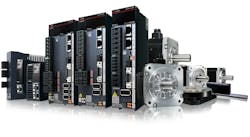Servos have played a key role in shaping the landscape of motion control systems, enabling new levels of accuracy, precision and dynamism. With cycle times measured in microseconds and the ability to effectively synchronize a multitude of axes, these components have helped manufacturing processes reach new heights. Machines equipped with these devices can move fast, delivering consistent results and have a remarkably high degree of repeatability.
Behind the scenes, the advanced hardware and software, as well as the communication standards and protocols that make up servos, play a pivotal role in supporting data-intensive, servo-based operations. This is why it’s critical for machine builders and end users to understand servo drives’ key components and technologies to deliver value-adding setups for their equipment and production lines.
Next-level performance
Certainly, one of the clearest trends in the evolution of servos is the drive to enhance speed and repeatability, requiring ever faster and reliable data sharing and processing capabilities. This acceleration and greater accuracy aren’t limited to a single axis—they extend to the synchronization of a growing number of axes, allowing for highly coordinated and dynamic movements within advanced machines. In addition, intelligent algorithms are being used to dampen disturbances, such as vibrations and harmonics, to ensure that motion remains smooth and precise, without deviations.
Furthermore, the reduction of setup time and need for adjustments means that even those with minimal programming expertise can configure as well as optimize servos and motion control operations efficiently. This can ultimately support companies taking the first steps towards the digitalization of their factories, helping them enhance their confidence and skillsets organically.
Beyond the basics
The capabilities of modern servos extend beyond basic operations, offering key tools to maximize their performance, uptime and service life. In particular, they have embraced artificial intelligence (AI) to support condition monitoring and predictive maintenance. Sensors embedded within servo amplifiers and motors continuously generate real-time data relating to the status of internal components and mechanical devices linked to the drives.
This continuous stream of data can be fed to predictive algorithms to detect wear and tear as well as identify anomalies well before they become critical issues. As a result, operators can take advantage of accurate, real-time insights on the status of their servos as well as leverage a system that recommends timely actions based on the condition of the components, rather than on pre-set schedules, while limiting unexpected equipment failure. This means that maintenance activities can be performed precisely when needed, preventing emergency shutdowns and unplanned downtime while optimizing equipment service life and maintenance scheduling, avoiding the replacement of healthy components.
The impact of this data-driven approach is profound, as it minimizes disruptions, enhances efficiency, and contributes significantly to cost savings. Modern servos, therefore, can play a pivotal role in ensuring that machinery runs smoothly, efficiently and with maximum availability.
The communications needs of advanced servos
Being equipped with the right communications technology is fundamental to unlocking the full potential of modern servos. Effective servo drive solutions are pivotal in driving speed, accuracy, precision and data-intensive functions for next-level applications.
Industrial Ethernet networks with large bandwidth, such as 1 Gbps, play a pivotal role. By offering high speed and sufficient capacity, this technology facilitates the swift exchange of substantial volumes of data between servos and control systems. As a result, it is possible to create motion systems with multiple axes and ultra-short cycle times—two necessities for the increasingly demanding applications of today's industries.
In addition, TSN supports the simultaneous transmission of diverse data traffic. This versatility enables the creation of networks that can effortlessly handle a wide variety of traffic types without delays or network congestion. In practice, time-critical messages for control operations can be transmitted seamlessly alongside less transient information, such as those used for AI analytics for condition monitoring and predictive maintenance. This ability therefore supports the sharing of information across the entire enterprise to support effective, data-driven decision making within smart factories.
The individual capabilities of 1Gbit transmission speed and TSN are formidable on their own. However, servo vendors and end users can greatly benefit from their integration into a single network technology, such as CC-Link IE TSN. The use of servos that leverage a network technology that combines these two solutions helps users set up motion control machines and applications that can handle vast data volumes and do so with remarkable precision and speed. This empowers the creation of intelligent digital manufacturing frameworks that maximize data availability and accessibility.
Machine builders and end users should realize that future-oriented servos should be built around the combination of gigabit bandwidth and TSN functions—the key elements necessary to develop advanced systems based on enhanced motion control capabilities. By favoring components featuring these technologies, end users are paving the way for data-driven applications that offer increased performance and competitiveness.
Tom Burke is the global director of industry standards at Mitsubishi Electric. Roy Kok is the senior partnerships and alliance specialist at CC-Link Partner Association (CLPA) Americas.

Leaders relevant to this article:


